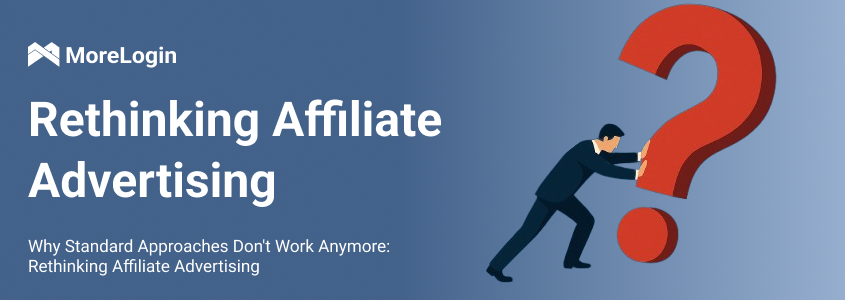
- Product

- Pricing
- Affiliate Program
- Use Cases
- Resource


The world of affiliate marketing is changing fast — and traditional ads no longer grab attention.
Users are becoming increasingly selective, and the information landscape is overloaded to the max. The same offers, the same wording, cookie-cutter creatives — all of it has become invisible.
What happened?
Advertising "blindness" isn’t a myth. Audiences are tired of clichés and ignore anything that looks like a direct sales pitch. This is especially noticeable in media buying: dozens of channels publish almost identical promos that are indistinguishable from one another. People scroll past without even reading.
But this isn’t a crisis — it’s a signal. It’s time to change. Time to give the audience something that truly resonates.
Content with character.
When an ad sounds like an opinion, experience, or story — it builds trust. The user doesn’t just consume the info; they relate it to their own life. That sparks emotion — and emotion leads to action and traffic.
People remember experiences:
"Here’s how I lost $300 on a bad offer."
"But with this offer, I recovered all my test budget in a week."
"What I’d tell myself a year ago when I started media buying."
These aren’t just words. They’re real experiences — and that’s why they resonate. And resonance leads to action.
Even if a case study only shows $50 in profit, if it’s written with honesty — showing what worked and what didn’t — it will land. Because people learn from others’ experiences. It’s not about how much you made — it’s about what you learned.
Old platforms can still perform — if you change your approach. Not an ad — but a story. Not benefits — but value. Add irony, sincerity, and a personal touch — and the reaction will be completely different.
Tell it like it is.
A post written with wit, self-irony, or an honest tone will always grab attention. Especially if, instead of:
"🔥 TOP OFFER! $1,000 a day!"
You write:
"Burned $200 for nothing. Then found one offer that didn’t drive me crazy with moderation. Here’s why it worked."
Feel the difference?
That’s not a “sales pitch,” that’s a story.
And people respond — because they’ve had the same screw-ups, the same hopes, the same tired eyes.
Native content isn’t a trend — it’s a necessity.
When an ad looks like a helpful post, it doesn’t trigger resistance. It reads like real content — especially when woven in naturally. And if you truly believe in the product, you’ll show it — and people will feel it.
Users don’t want to see ads — they want to see valuable or interesting content, with the promotion seamlessly integrated. That could be a personal story, a case study, a tool breakdown, or an expert’s take on an offer.
When advertising doesn’t scream “BUY NOW,” but instead answers a real need, it’s received with much more trust.
Recently, we worked with a young Telegram channel in the traffic niche. The first direct ad post brought 3 leads. A similar offer, formatted as a personal story, brought 29.
Why? Because behind the story — was a human. Behind the post — experience. And behind that experience — trust.
We also tested a storytelling-based series. The result: conversion rates nearly tripled, with positive reactions in the comments. Regular posts didn’t get that kind of effect.
Classics aren’t dead — but they’re just part of the mix.
You often hear that classic ad posts are outdated. That they don’t resonate, get lost in feeds, and no longer work. It sounds logical — but it’s one-sided.
Direct posts aren’t dead. They’re still great at what they do best: creating reach, building awareness, and planting the seed. That crucial first contact still starts here.
But if your goal isn’t just to flash on someone’s feed — but to get a reaction, engagement, and build loyalty — a direct post isn’t enough. You need a smarter strategy: a flexible, well-thought-out mix, where each format serves its purpose.
Add native presentation, and the ad stops feeling foreign. It becomes part of the content, absorbed naturally — and that’s what builds engagement. First-person stories, with real experience, mistakes, or insights, create trust. The reader sees themselves in your words, feels seen — and reacts.
Constant, subtle brand presence through ambassadors builds loyalty. People begin to see the product as part of everyday life, not just a one-time offer.
So don’t get stuck on just one format. Experiment. Try different styles, change the tone, play with formats. Don’t be afraid to be “unconventional” — your audience is tired of cookie-cutter voices and generic structures. It’s boldness, flexibility, and the ability to speak human that separates effective affiliate ads from background noise.
And don’t forget the technical side.
That matters too. Many pros use tools like MoreLogin browser to manage multiple accounts safely, avoiding bans. Especially important when running campaigns across different geos or sources — the “infrastructure” of a successful affiliate matters.
People no longer respond to loud slogans. They respond to honesty, value, and emotion. Today, it’s not the loudest who wins — but the one who hits the nerve.
If your ad sparks any kind of emotion — that’s already half the battle.
And yes, if you want to launch a campaign that won’t land in the “blind zone” — make it feel alive.
Then the audience will respond — and the partner will be satisfied.